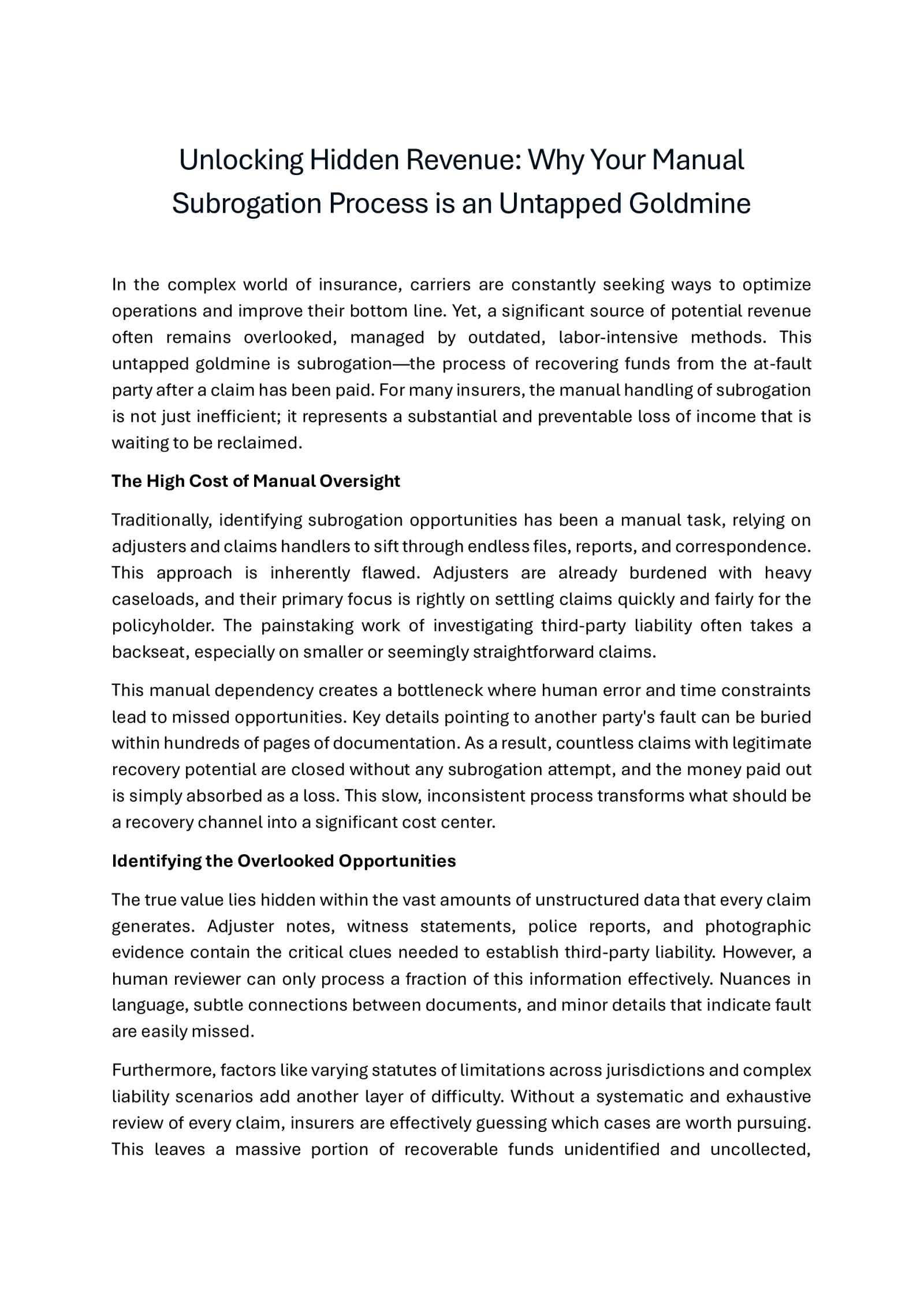A presentation at AI-powered recoveries in insurance by Charmaine Miller

Unlocking Hidden Revenue: Why Your Manual Subrogation Process is an Untapped Goldmine In the complex world of insurance, carriers are constantly seeking ways to optimize operations and improve their bottom line. Yet, a significant source of potential revenue often remains overlooked, managed by outdated, labor-intensive methods. This untapped goldmine is subrogation—the process of recovering funds from the at-fault party after a claim has been paid. For many insurers, the manual handling of subrogation is not just inefficient; it represents a substantial and preventable loss of income that is waiting to be reclaimed. The High Cost of Manual Oversight Traditionally, identifying subrogation opportunities has been a manual task, relying on adjusters and claims handlers to sift through endless files, reports, and correspondence. This approach is inherently flawed. Adjusters are already burdened with heavy caseloads, and their primary focus is rightly on settling claims quickly and fairly for the policyholder. The painstaking work of investigating third-party liability often takes a backseat, especially on smaller or seemingly straightforward claims. This manual dependency creates a bottleneck where human error and time constraints lead to missed opportunities. Key details pointing to another party’s fault can be buried within hundreds of pages of documentation. As a result, countless claims with legitimate recovery potential are closed without any subrogation attempt, and the money paid out is simply absorbed as a loss. This slow, inconsistent process transforms what should be a recovery channel into a significant cost center. Identifying the Overlooked Opportunities The true value lies hidden within the vast amounts of unstructured data that every claim generates. Adjuster notes, witness statements, police reports, and photographic evidence contain the critical clues needed to establish third-party liability. However, a human reviewer can only process a fraction of this information effectively. Nuances in language, subtle connections between documents, and minor details that indicate fault are easily missed. Furthermore, factors like varying statutes of limitations across jurisdictions and complex liability scenarios add another layer of difficulty. Without a systematic and exhaustive review of every claim, insurers are effectively guessing which cases are worth pursuing. This leaves a massive portion of recoverable funds unidentified and uncollected,
representing a direct hit to an insurer’s financial performance and loss ratios. The gold isn’t missing; it’s just buried too deep for manual tools to find consistently. The Shift to Intelligent Automation The key to unlocking this hidden revenue is moving from manual effort to intelligent automation. Modern technology is now capable of analyzing entire claim files in seconds, not hours or days. By leveraging sophisticated algorithms, these systems can scan and interpret both structured and unstructured data to flag claims with a high probability of successful recovery. This is where the industry is seeing the impact of AI-powered recoveries in insurance. This technological leap doesn’t replace the expertise of subrogation professionals; it enhances it. Automation handles the time-consuming discovery phase, presenting adjusters with a prioritized list of viable subrogation cases, complete with supporting evidence. This allows skilled human teams to stop searching for opportunities and start focusing their efforts on the high-value work of negotiation and settlement, dramatically increasing both the volume and success rate of recoveries. From Cost Center to Profit Center Rethinking the subrogation process is no longer just an operational improvement; it is a strategic imperative. By moving beyond manual review and embracing technology, insurance carriers can transform subrogation from a sluggish cost center into a dynamic and predictable revenue stream. Systematically analyzing all claims data ensures that no opportunity is left behind. This proactive approach not only recovers millions in otherwise lost funds but also improves overall financial health, creating a more sustainable and competitive business model for the future.
Discover how AI-powered recovery solutions transformed claims processing, driving revenue growth and operational efficiency for a leading insurer.